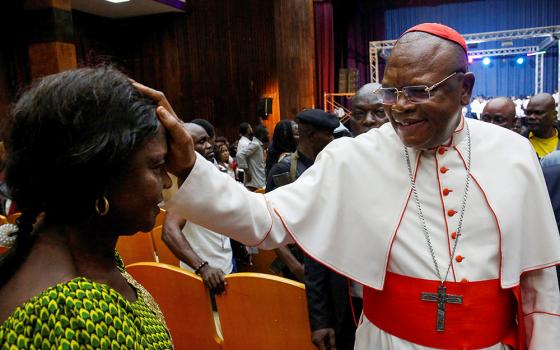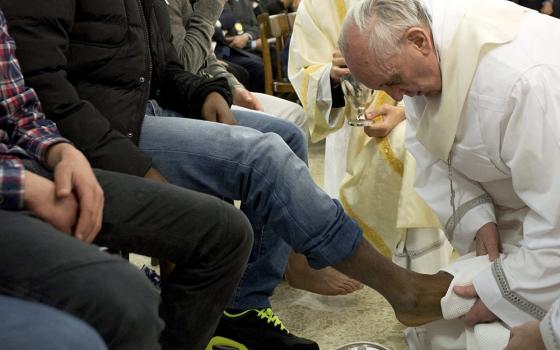Three days after a new study suggested a majority of Catholic parish leaders think a controversial new series of liturgical translations should not go forward, the U.S. bishops are debating here Monday whether to approve those translations.
The bishops are expected to vote yay or nay Tuesday on the translations, which are the latest in a series of new texts bishops across the English-speaking world have approved following the Vatican's 2001 publication of a new set of norms for translation from the Latin originals.
It will be the first time in four years that the bishops will vote to approve translations of Mass prayers. The last time the bishops did so, in June 2009, they had to poll nonattending bishops by mail in order to reach the two-thirds approval mark required under the U.S. bishops' conference's bylaws.
Most of the new English-language texts, which govern the prayers of the Catholic Mass and are known together as the Roman Missal, went into use by Catholics across the U.S. in November 2011.
Up for debate at this fall's bishops' meeting are four sets of translations not included when the U.S. bishops approved the missal in separate votes in 2006 and 2009.
Two of the translations deal with Spanish-language versions of the Mass commonly used in the U.S. The other two are new English texts for the Catholic rites of marriage and confirmation.
Preliminary findings released Friday by the Diekmann Center for Patristics and Liturgical Studies at Saint John's University School of Theology-Seminary in Collegeville, Minn., found that 41 percent of U.S. Catholic parish leaders agree that the style used in the Mass translation should be used for other rites, like marriage and confirmation.
Most leaders (52 percent) disagreed that such rites should be translated similarly, the study found.
The Diekmann Center commissioned a study of the acceptance of the Mass translations by Georgetown University's Center for Applied Research in the Apostolate. The results released Friday are preliminary results only. Final results are expected in January.
The bishops are meeting in Baltimore Monday through Thursday. They spent about fifteen minutes clarifying issues on the translations Monday afternoon and are expected to vote on them Tuesday morning.
Those new norms for translation were published in the document Liturgiam authenticam, which called for translations from the Latin to be made in "the most exact manner."
Catholics across the country, including several bishops, have critiqued the new standards for translation, saying they lead to rigid and sometimes even grammatically incorrect sentences.
On the floor of the bishops' meeting in 2009, Bishop Donald Trautman of Erie, Pa., pointedly asked his confreres about one of the new sentences: "What does that even mean?"
Stating similar concerns with the new German adaptations of the Mass, Germany's bishops voted in September to table indefinitely a series of new translations made in their language according to the guidelines of Liturgiam authenticam.
Many of the texts in the new marriage rite align with those already given the green light by the bishops in the 2009 vote, when the prelates approved a set of prayers that can be used in various ritual events. Among texts in the rite the bishops will vote on for the first time are the central parts of the marriage ceremony: the giving of consent of the bride and groom, the making of the vows and the blessing of their rings.
One sentence that appears in both the 2009 and 2013 marriage texts that may strike a chord with some is a reference to the bride as an "inseparable helpmate" to her husband.
The new English text for the confirmation rite is a retranslation of the original Latin language for the rite, which was revised in 1971 following revisions ordered by the Second Vatican Council.
A release from the bishops' conference said the confirmation rite was retranslated in order to fit the norms of Liturgiam authenticam.
Although the bishops' staffer in charge of the office that shephered the translations said in October he didn't think the bishops would enter into lengthy debate on them, he also said that "if they want to have debates about particular translations or particular phrasing, they are free to do so."
Msgr. Richard Hilgartner, the executive director of the U.S. bishops' secretariat for divine worship, said in a phone interview Oct. 23 that the bishops had first seen versions of the new rites last year.
Last summer, the bishops received copies of the rites via email from the worship committee and were given "about three months" to submit comments back to the committee, Hilgartner said.
The committee then compiled the comments and sent them on to the International Committee on English in the Liturgy (ICEL), the group first set up in 1963 by bishops from English-speaking countries to facilitate translation of liturgical texts into English.
The leadership of the commission was substantially changed by the Vatican in 2003 to align with the Liturgiam authenticam norms and was placed under the authority of an official Vatican commission known as Vox Clara.
The versions of the texts the U.S. bishops will vote on Tuesday are versions of the rites adapted by ICEL from comments made by bishops in each of the commissions 11 English-speaking counties, which are undergoing changes to the same ritual texts at the same time, Hilgartner said.
Given the number of comments from around the world, Hilgartner said it is hard to know if a particular bishop's concerns about the translations were incorporated into the final drafts.
"One bishop could have submitted a comment that went in one direction and another bishop could have submitted the exact opposite comment," Hilgartner said. "It's difficult to know because we only know what our conference submitted. They were free to say what they wanted, so we could have had conflicting comments."
An official at ICEL's headquarters in Washington who asked not to be named because of the range of feedback the commission has received on its translations said in October it made the translations of the rites in accordance with Liturgiam authenticam and the new English-language Roman Missal.
The missal, the official said, is now considered "informative for how to do translations of other ritual material, such as marriage and confirmation.
"For example, if there's a rubric or prayer or phrase or entire prayer that's in the missal that's repeated in marriage, that final text of the missal would be the one that's used," the official said.
The opening pages of the new marriage rites, first approved by Vatican prelates in 1969, instruct bishops' conferences to make adaptations to the rites' texts "so as to achieve the conscious and active participation of the faithful" and so that the texts are "truly accommodated to the nature of different languages and the character of diverse cultures."
Those instructions allow the bishops to:
- Adapt formulas of prayers or supplement the provided formulas;
- Add additional prayers when there are several options available;
- Change the order of the parts so long as "the structure of the sacramental rite is preserved";
- Omit certain rites, like the joining of the hands or giving of rings, when they are "incompatible with the culture of the people";
- Adopt local customs or traditions by considering "carefully and prudently what elements ... may appropriately be adopted."
[Joshua J. McElwee is NCR national correspondent. His email address is jmcelwee@ncronline.org. Follow him on Twitter: @joshjmac.]






